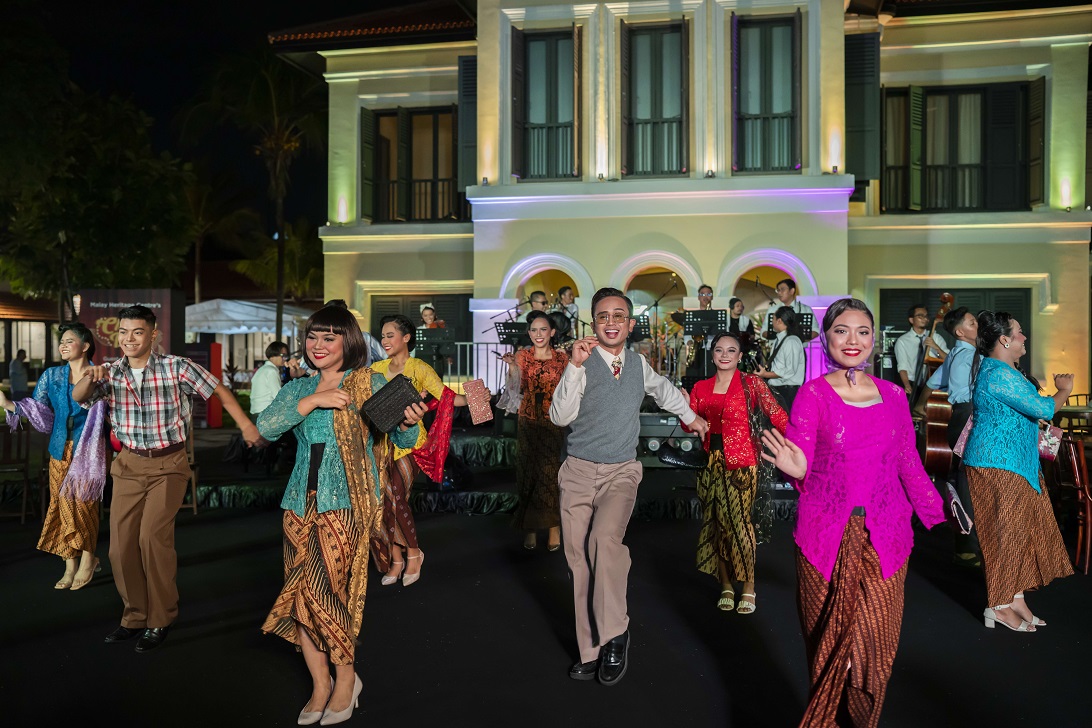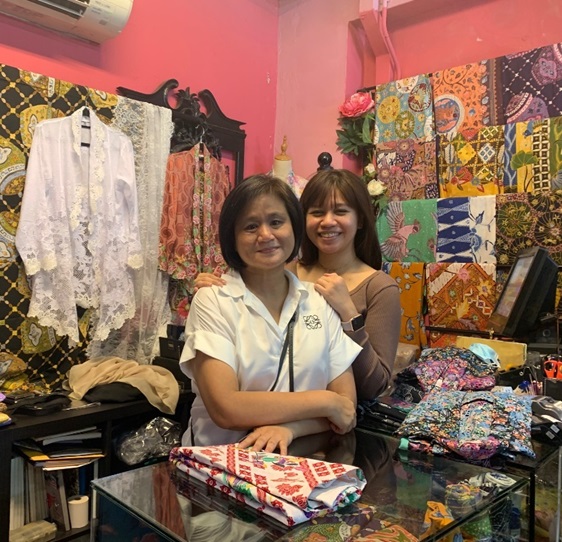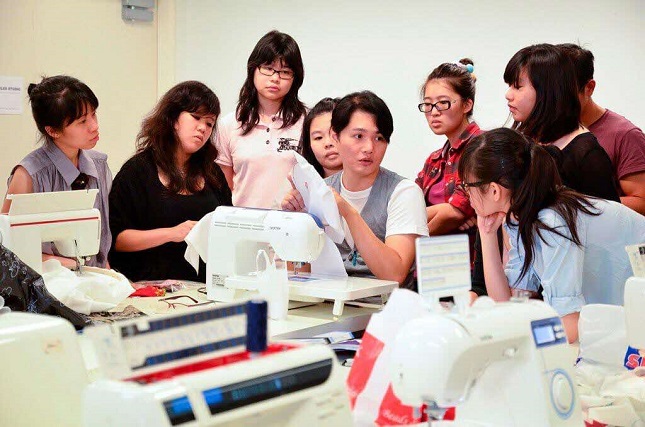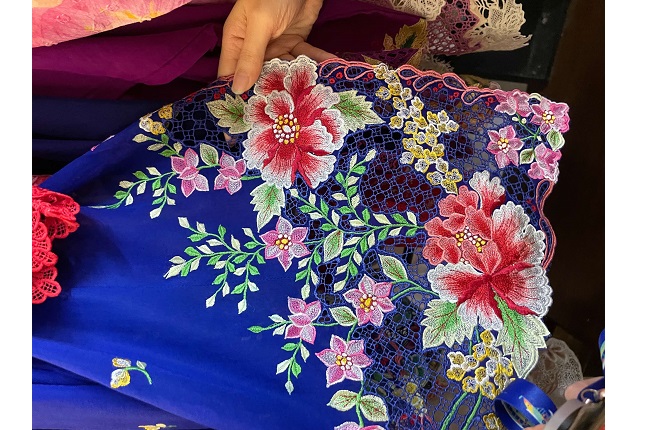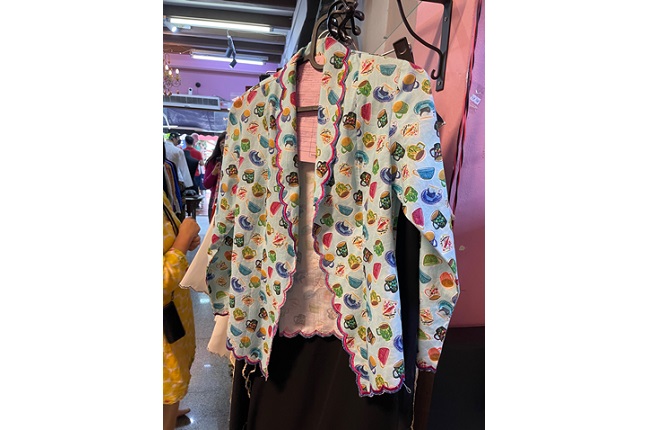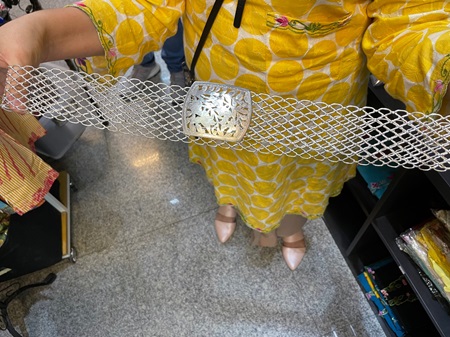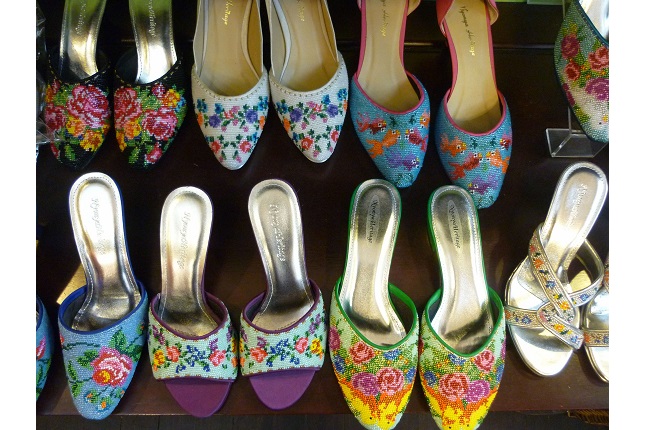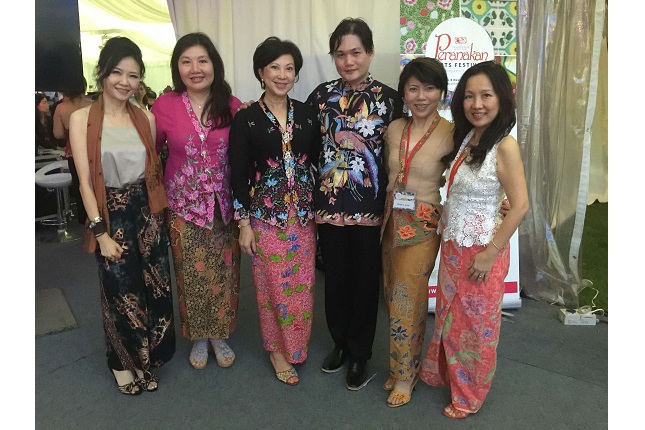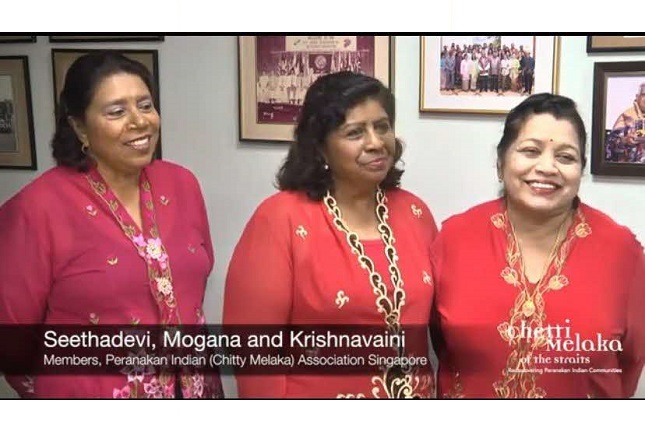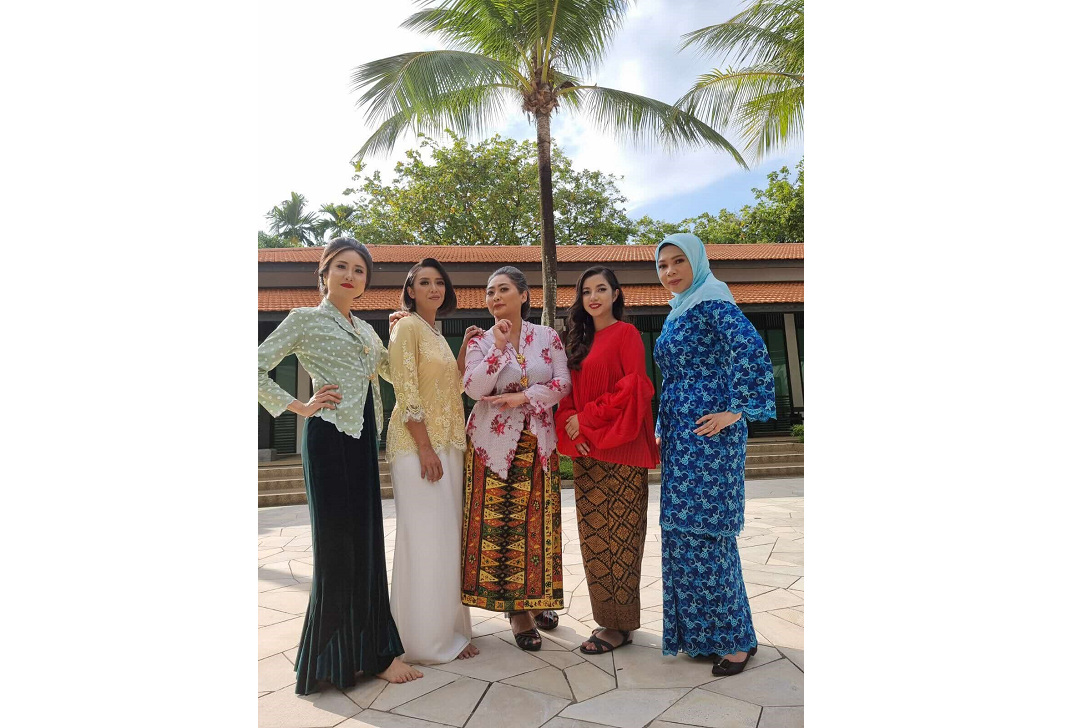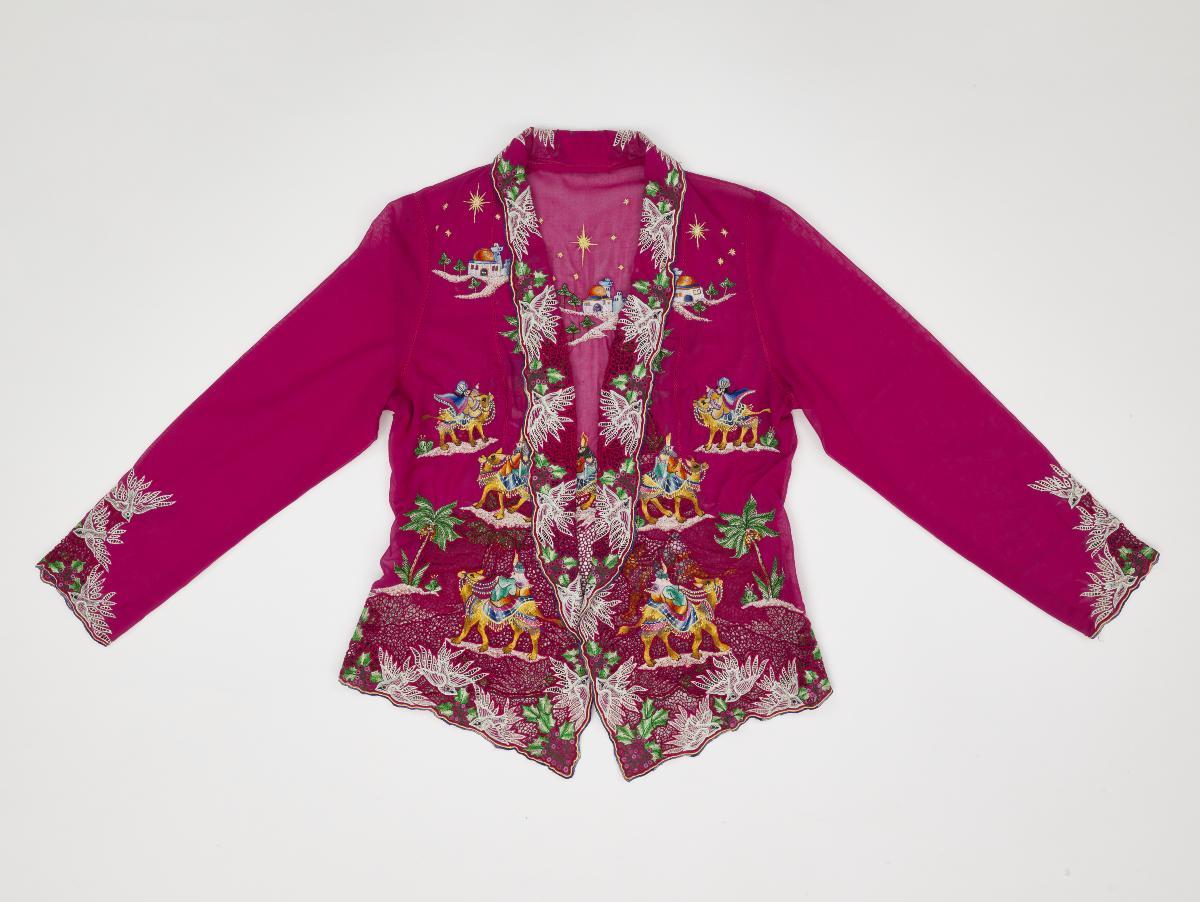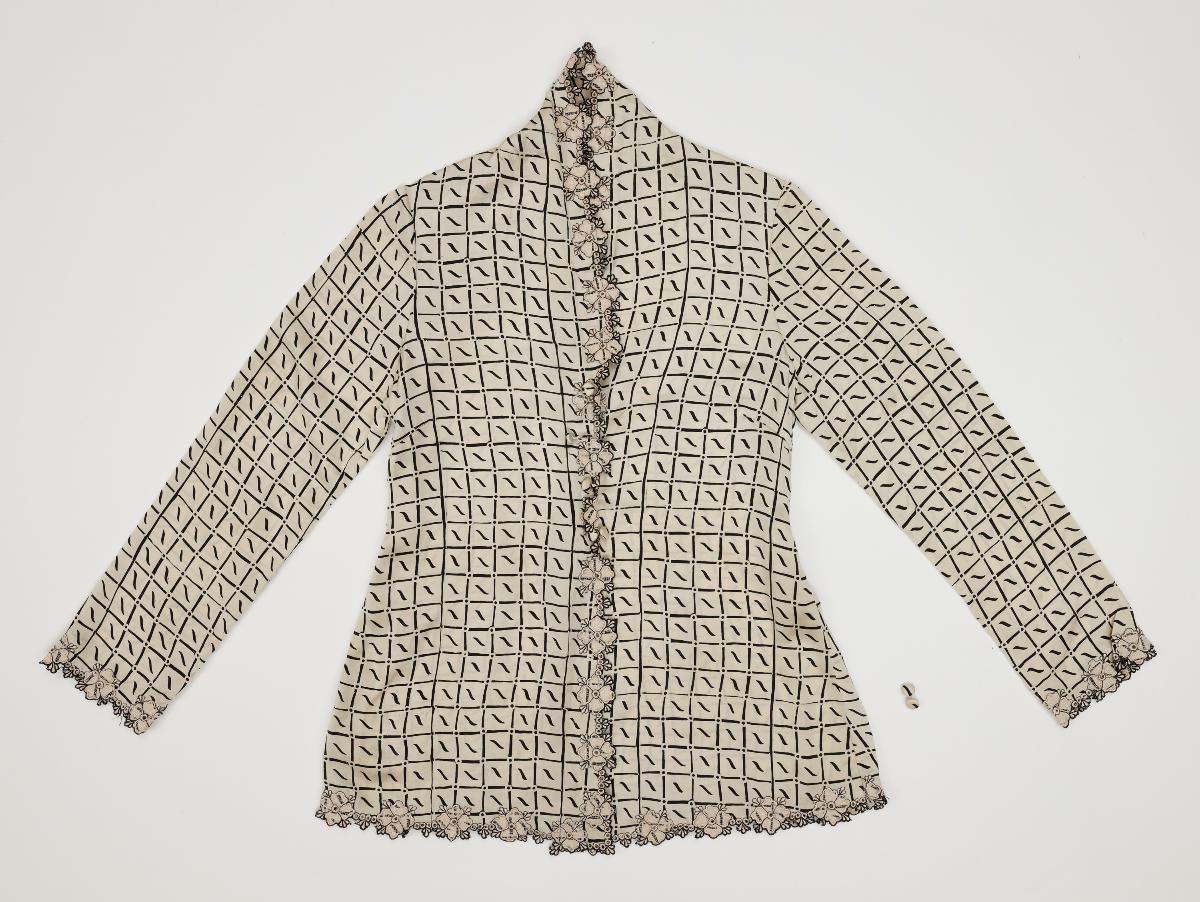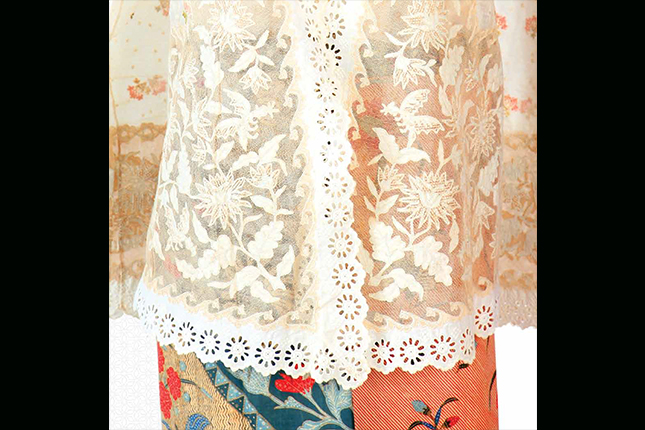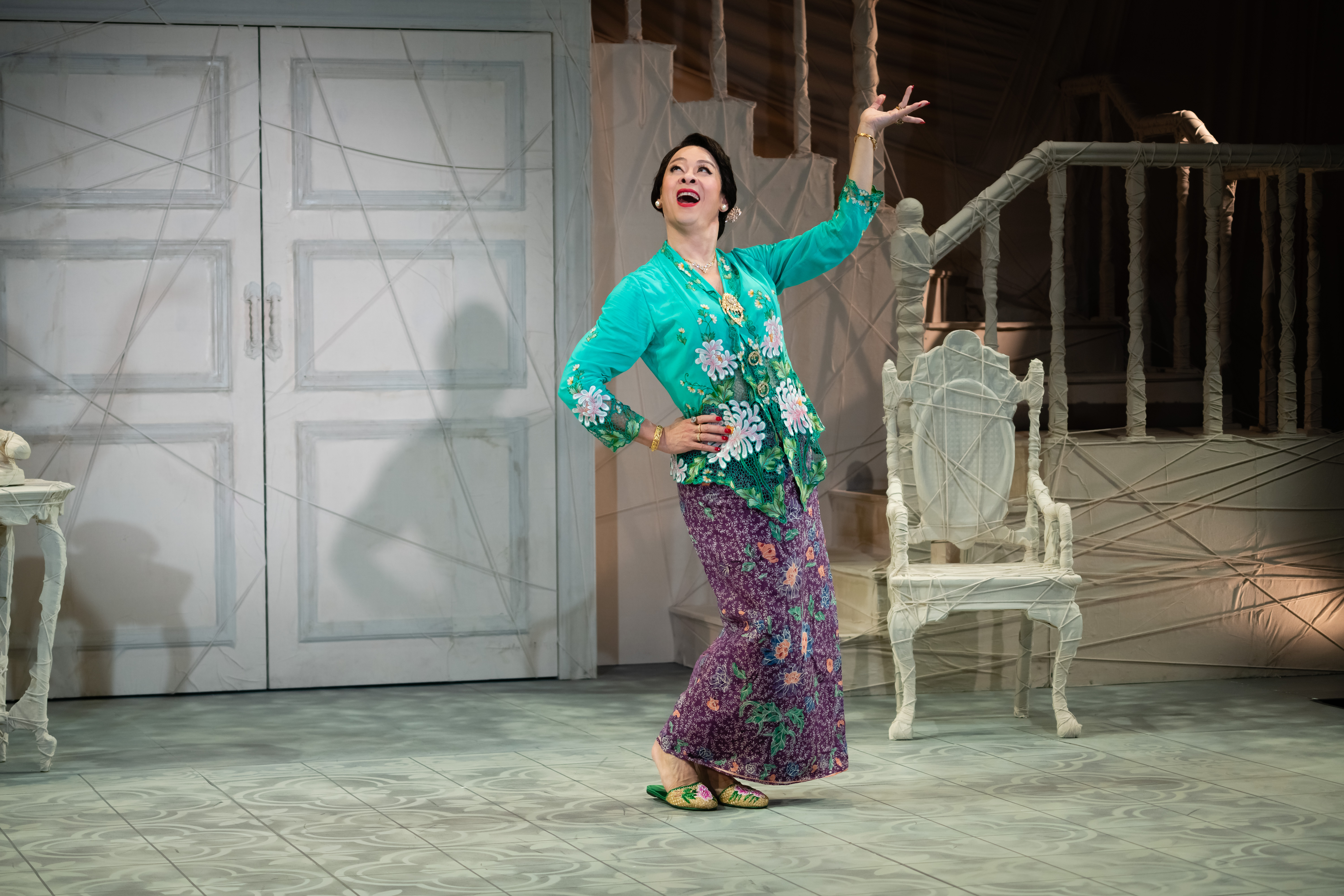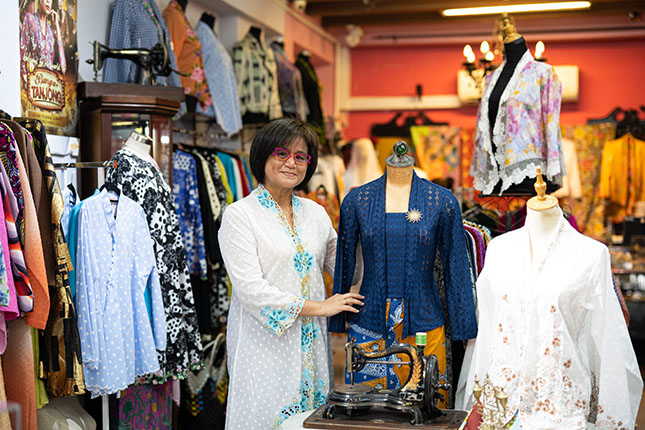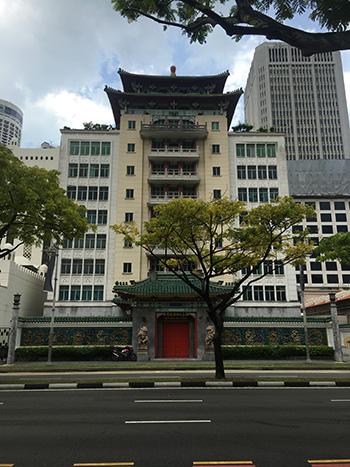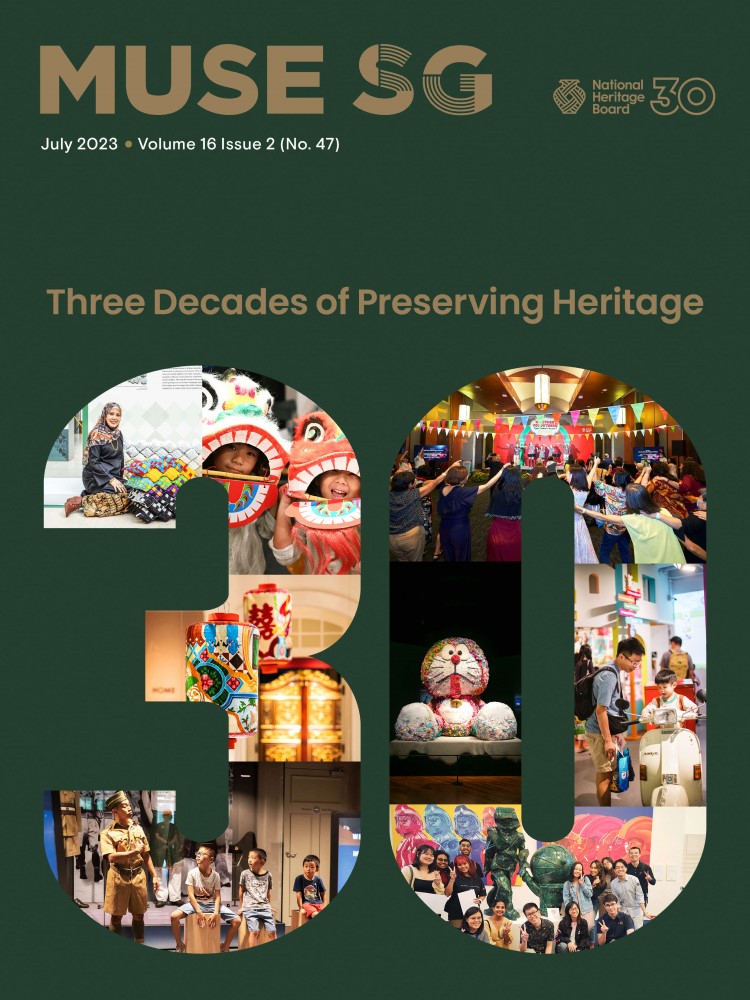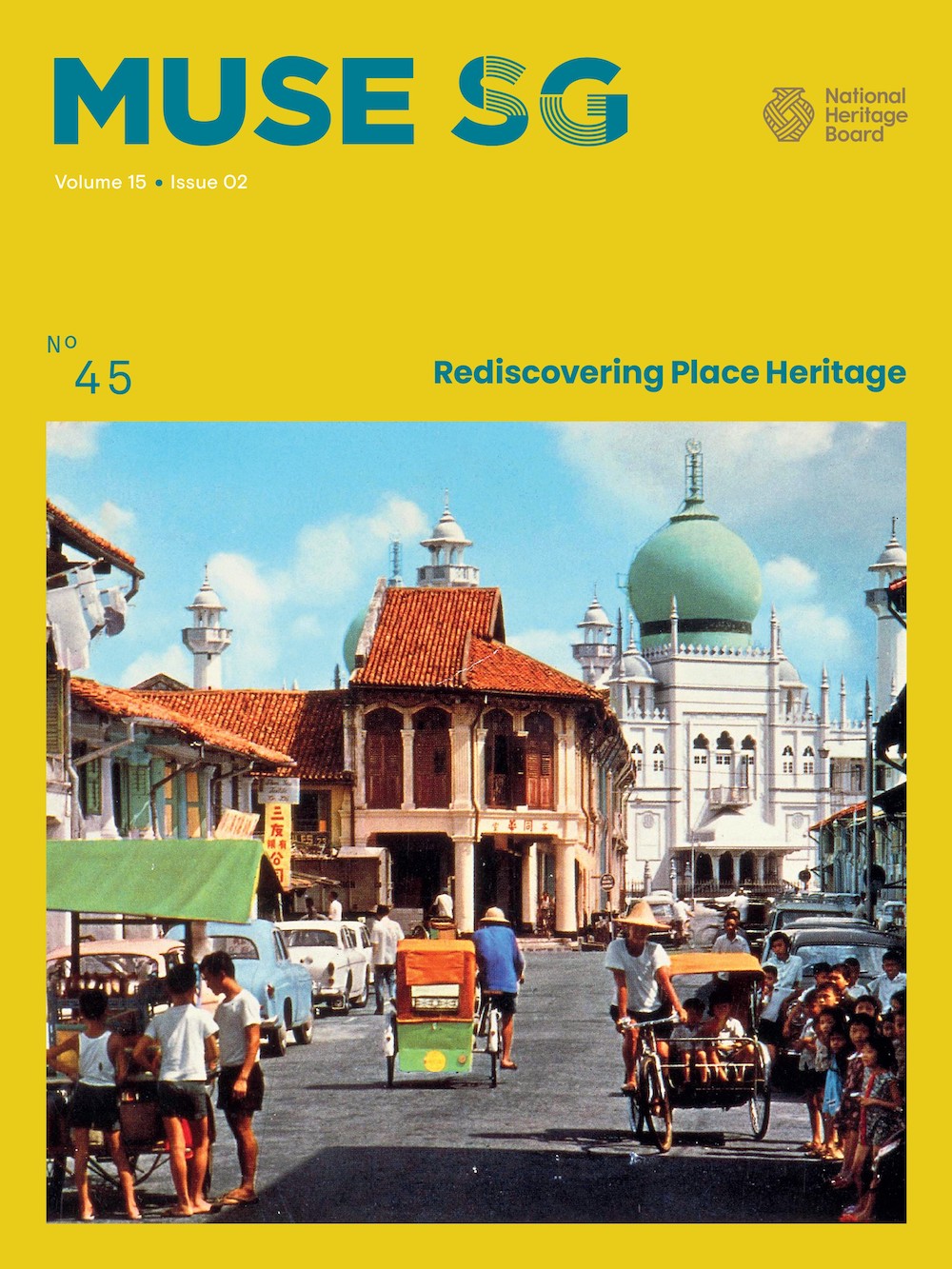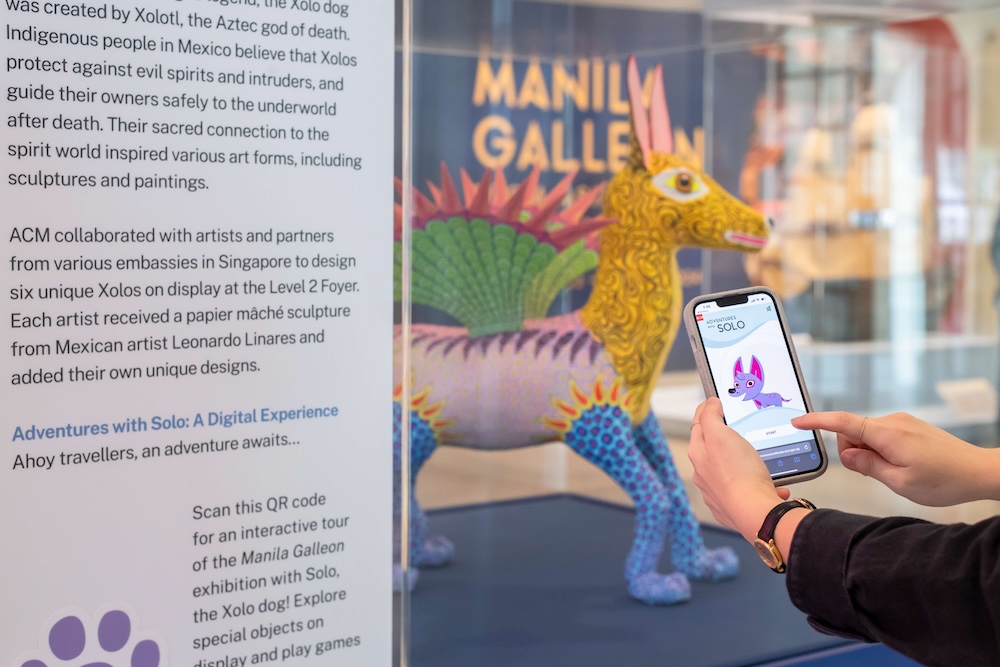Craft and Practices related to Kebaya
Kebaya is an upper garment that is traditionally made from fabrics such as velvet, cotton, gauze, lace, or voile, and at times adorned with embroidery. It is typically identified as a blouse or tunic with the collar extending from the back of the neck down to the hems on either side of the front body. The front is secured with either buttons, pins, or kerongsang (brooch), with an accompanying lower garment known as sarong or kain; a long piece of cloth wrapped and tucked around the waist, which may at times secured with a tali pinggang (belt) or stagen (cummerbund).
In Singapore, kebaya is worn by women from various communities. It has, and continues to be, a central aspect in the representation and display of cultural heritage and identity for Malay, Peranakan, and other communities in Singapore, and is a notable part of our heritage as a multi-cultural port city.
Geographic Location
Kebaya is traditionally worn by women in Southeast Asia, notably in Singapore, Brunei, Indonesia, Malaysia, and Thailand. As maritime trade grew over time, kebaya gradually became increasingly prevalent in Malay and Peranakan communities, including in Singapore, as a multi-cultural port city, with links across many communities in Southeast Asia and the world.
While the styles of kebaya and sarong, as well as the materials and embellishments that are worn with them vary across the region, there are generally two basic styles of kebaya, namely kebaya panjang/labuh (long kebaya) and kebaya pendek (short kebaya). Kebaya panjang/labuh is a full-length dress with a front opening that is traditionally fastened with either kerongsang (brooch), pins or buttons. Kebaya pendek reaches the hip and is recognisable through its distinct figure-hugging characteristic that is made to emphasise the silhouette of the body. The latter style of kebaya was especially popular among young women in cities like Singapore, Kuala Lumpur, and Penang.
Communities Involved
Kebaya can be worn by women of all ethnicities, although it is most commonly associated with the Malay and Peranakan communities in Singapore, and is worn on both formal and casual occasions. It is important to note that kebaya is not just a garment but an important medium in which Malay and Peranakan cultures may be represented, through the various motifs embroidered and distinctive ways it is worn by the wearer, and a reflection of the ornate skills and expertise of the maker.
Given Singapore’s Malay and port city heritage which brought together various cultures and influences from around the region, kebaya designs commonly demonstrate a blending of cultures. For example, a kebaya may feature traditional Javanese motifs and batik patterns such as the kawung (palm fruit), or motifs from Malay, Chinese, Indian, and European cultures, be they flowers, animals, mythical creatures, or figurative elements. The embroidery may be found throughout, or along the edges such as the neckline, sleeves, and bottom ends of the kebaya, and sewn using embroidery threads with a variety of colours.
Associated Social and Cultural Practices
Kebaya has often been used as a symbol of cultural heritage, with the developments and customs of this traditional dress commonly associated with socio-cultural identity. Kebaya has – and especially so in recent years – been a central aspect in the representation and display of cultural heritage and identity to the Malay and Peranakan communities in Singapore. Kebaya is commonly worn during festive occasions such as Hari Raya Puasa (roots.gov.sg), Chinese New Year (roots.gov.sg), Deepavali (roots.gov.sg), at important rites of passage such as weddings, formal events, parties, and even non-formal occasions. Additionally, kebaya has been adapted and continues to be the attire for both Singapore Airlines and Malaysia Airlines flight attendants, ever since it was introduced by Malaysia-Singapore Airlines in 1968.
The cultural heritage, traditional customs, and identities of the communities are also represented through the various intricacies and accompaniments that are commonly associated with the complete kebaya outfit. The wearing of kebaya oftentimes goes in hand with the following accompaniments, and are typically transmitted over generations.
The main accompaniment to kebaya is known as kain panjang/kain lepas or simply, kain (a long piece of rectangular cloth wrapped and tucked around the waist) or sarong (a stitched, tubular skirt). Both the kain and sarong are typically around three metres in length, are made of various textiles such as batik, songket, tenun, and pelikat.
Kebaya is also commonly accompanied by a kerongsang (brooch) pinned down the chest and used to secure the blouse opening in the front of several variations of kebaya. The use of the kerongsang typically relates to the weight of the fabric; a kebaya with heavier fabric typically features a larger and more elaborate set, while one with a lighter fabric typically utilises only one or two individual pieces which are comparatively smaller in size. The kerongsang used may also differ depending on whether it is used with kebaya panjang/labuh or kebaya pendek. Additionally, a tali pinggang (belt) or stagen (cummerbund) may be worn around the waist to secure the sarong, and for the latter, to give a distinct silhouette to the wearer. Traditional shoes are another popular accompaniment to kebaya, with slippers intricately covered with beaded or threaded embroidery known as kasut manek, and velvet shoes embroidered with tekat suji benang emas (gold thread).
In addition to the various accessories commonly associated with kebaya, it is also featured in several traditional performing art forms such as Malay Dance Forms (roots.gov.sg, Dondang Sayang (roots.gov.sg), Wayang Peranakan (roots.gov.sg), and has also been presented in contemporary theatre productions such as Emily of Emerald Hill (roots.gov.sg). Cultural associations such as Sri Warisan and Gunong Sayang Association, for example, put concerted effort into ensuring performers are educated on the various intricacies of kebaya. This is to encourage their community of performers to appreciate the cultural and technical significance of kebaya, and its distinctive accessories, in order to perform an informed rendition of the dance and the cultures represented. Ensuring that kebaya is understood and is worn appropriately, even when it is modified for the purposes of performance, is regarded as a mark of respect for the audience and the communities involved. More importantly, the prominent use of kebaya in these art forms serve as representations of the communities’ cultural identities and heritage, which extend beyond festive and social events, and towards performing arts – highlighting the versatility of kebaya.
In earlier years, the skills associated with the sewing and embroidery techniques were transmitted from mother to daughter over generations. Over time, the craft and practice of sewing and embroidering kebaya came to involve men as well. The transmission of knowledge on the different embroidery styles and sewing work has since extended to formal and informal education, as well as workshops and classes helmed by craft practitioners. These platforms continue to impart the mastery of kebaya-making to larger segments of society, including the younger generation.
Experience of a Practitioner
Mdm Ratianah Tahir is a craftsperson of kebaya and sulam (embroidery) in Singapore, and designer and owner of the boutique store Kebaya by Ratianah on Bussorah Street in Kampong Gelam. Mdm Ratianah picked up sewing at a young age and began honing her craft after the birth of her first child, taking classes and apprenticing under the tutelage of her sister-in-law and late mother-in-law, both of whom were skilled at sewing traditional clothing. She sees her role not only as an entrepreneur, but, as a woman in the Malay community who safeguards and promotes the making, wearing and appreciation of kebaya.
Seeing a lack of fashion establishments focusing on traditional clothing, Mdm Ratianah decided to start her own business selling kebaya and related accessories at Bali Lane in 2005, before relocating to Kandahar Street, and finally to the present location (Bussorah Street) in 2012. Mdm Ratianah’s vision is to cultivate an appreciation and love for kebaya among Singaporeans, especially the younger generation. Her efforts include a fresher-take of kebaya styles by incorporating design elements which appeal to youths – for example, kebaya with cat prints, or emoji-like motifs for a more flamboyant take on kebaya.
Today, her 29-year-old daughter Putri Nadirah Hassan, helps run the store and manage customers, as well as styling fashion shoots for the shop. Putri promotes kebaya to younger customers through social media marketing and promotion of her mother’s modern kebaya designs. Their philosophy is simple – wanting to share the knowledge and passion for kebaya fashion with as many people as possible, and to ensure that kebaya will continue to be worn by successive generations of Singaporeans, regardless of their ethnic or cultural backgrounds.
Present Status
Kebaya is a microcosm of the melting pot of cultures and craft traditions in Singapore and the region, and continues to serve as an important representation of cultural heritage within these communities in both formal and casual settings. There has also been increased interest from women in the communities to wear kebaya, and interest from the wider community to make kebaya. Kebaya has also since evolved to include modern designs and kebaya-inspired outfits to offer a wider range of use, and to keep the viability, significance, and practice of kebaya relevant to changing lifestyles and preferences.
Aside from the modernisation of kebaya styles, current transmission efforts and initiatives include festivals and theatrical productions – this is exemplified by “Kebaya Homies”, a 2019 musical presented by The Necessary Stage in collaboration with M1 Singapore Fringe Festival, which depicted Malay history and culture through the medium of kebaya. Similarly, ‘Bunga Tanjong’, an award-winning Malay drama about women in the 1950s, has played a crucial role in bringing kebaya back into the spotlight. The Malay Heritage Centre, Malay Heritage Foundation, Asian Civilisations Museum, Peranakan Museum, and Indian Heritage Centre in Singapore are also key proponents of kebaya, with past efforts including ‘Fesyen Forward,’ an art installation featuring illustrations of women in the various styles of kebaya, ‘#FilterLife Weekend Festival,’ the ‘Armenian Street Party’ which showcased different aspects of Peranakan culture from music to dress, to craft workshops, and an exhibition on ‘Chetti Melaka of the Straits’ in collaboration with the Association of Peranakan Indians.
Additionally, practitioners such as Ms Oniatta Effendi, Mr Heath Yeo, and Mr Raymond Wong propagate the craft and practices related to kebaya to the wider community in various ways. Ms Oniatta facilitates knowledge exchange on the social history and cultural experience of Malay heritage textiles through regular talks and workshops at her boutique and online posts. Meanwhile Mr Yeo shares and gives live demonstrations of the process of creating sulam (embroidery) designs using the manual treadle sewing machine, and Mr Wong holds workshops and classes on Nyonya Beadwork and Embroidery (roots.gov.sg), in addition to formal courses and classes in educational institutions such as LASALLE College of the Arts. This ecosystem of initiatives and measures serve to safeguard and transmit the intricate knowledge and understanding of the craft and practices related to kebaya for the next generation.
References
Reference No.: ICH-102
Date of Inclusion: October 2022; Updated March 2023
Fong, Karen. Celebrating hospitality: The Sarong Kebaya Uniform Turns 50 - SilverKris. Published October 1, 2018, Updated 18 Aug 2022. https://www.silverkris.com/airline/news-from-sia/sarong-kebaya-uniform-turns-50/
Jaafar, Rosita. Sewing Technique: Malay Traditional Attire/ Teknik Menjahit: Pakaian Tradisi Melayu. Kuala Lumpur: FTIM Designing Centre, 2009.
Karyaningsih, Endang Wani. "Faktor-faktor yang mempengaruhi pemilihan kebaya pada ibu-ibu dan remaja putri." KELUARGA: Jurnal Ilmiah Pendidikan Kesejahteraan Keluarga 1, no. 1, 2015.
Khor, Samantha. The Origin of the Kebaya and How It Became an ASEAN Icon. https://www.airasia.com/play/assets/blt53f2336bf71319a7/the-origin-of-the-kebaya-and-how-it-became-an-asean-icon
Koh, Jamie. “Nyonya Kebaya.” Published September 2013. https://eresources.nlb.gov.sg/infopedia/articles/SIP_2013-09-27_173744.html
Lee, Peter. “Peranakan Fashion and Its International Sources: Sarong Kebaya.” National Heritage Board, BeMuse Volume 4 Issue 2, 2012. https://www.roots.gov.sg/stories-landing/stories/peranakan-fashion-and-its-international-sources/story
Lee, Peter. Sarong Kebaya: Peranakan Fashion in an Interconnected World 1500-1950. Singapore: Asian Civilisations Museum, 2014.
Lee, Su Kim. Kebaya Tales: Of Matriarchs, Maidens, Mistresses, and Matchmakers. Singapore: Marshall Cavendish Editions, 2019.
Mahmood, Endon (Datin Seri). Nyonya Kebaya: A Century of Straits Chinese Costume. Vermont: Tuttle Publishing, 2012.
National Heritage Board. “Singapore, Sarong Kebaya and Style: Peranakan Fashion.” 2016. https://artsandculture.google.com/story/singapore-sarong-kebaya-and-style-peranakan-fashion-national-heritage-board-singapore/6AVxGAwa3F7DJA?hl=en
Ong, Christine Kiat Neo. Nyonya Kebaya: Intricacies of the Peranakan Heritage. Singapore: Christine Ong Kiat Neo, 2011.
Salamat, Hidayah. “Ratianah Tahir wants to bring back our ‘romance’ with the kebaya.” CAN Lifestyle. Published 13 April 2022. https://cnalifestyle.channelnewsasia.com/women/ratianah-tahir-kebaya-baju-kurung-kampong-glam-bussorah-street-308946.
Tan, Yvonne. Nationalising the Kebaya in the Nusantara. Kuala Lumpur: O For Other, 2020.
Yak, Jessie, and Sundari Balasubramaniam. “In Vogue: Singapore Fashion Trends from 1960s to 1990s.” Biblioasia, Vol. 10, Issue 3, 2014. https://biblioasia.nlb.gov.sg/vol-10/issue-3/oct-dec-2014/singapore-fashion-trends-1960s-1990s
Yusof, Zarina, Norwani Md Nawawi, and Asliza Aris. "Malay Kebaya: The History and Influences of Other Silhoutte." In Proceedings of the Art and Design International Conference (AnDIC 2016), pp. 445-452. Springer: Singapore, 2018.




